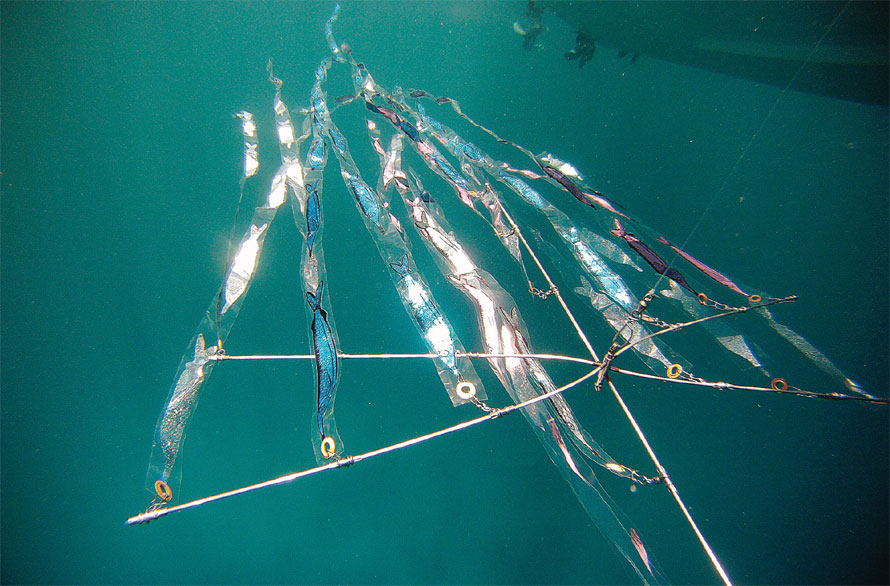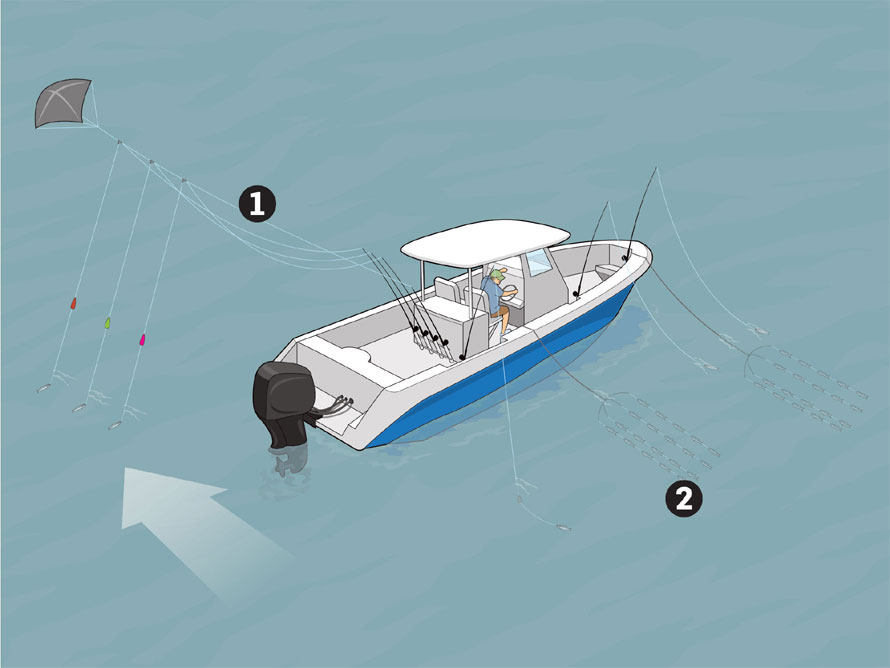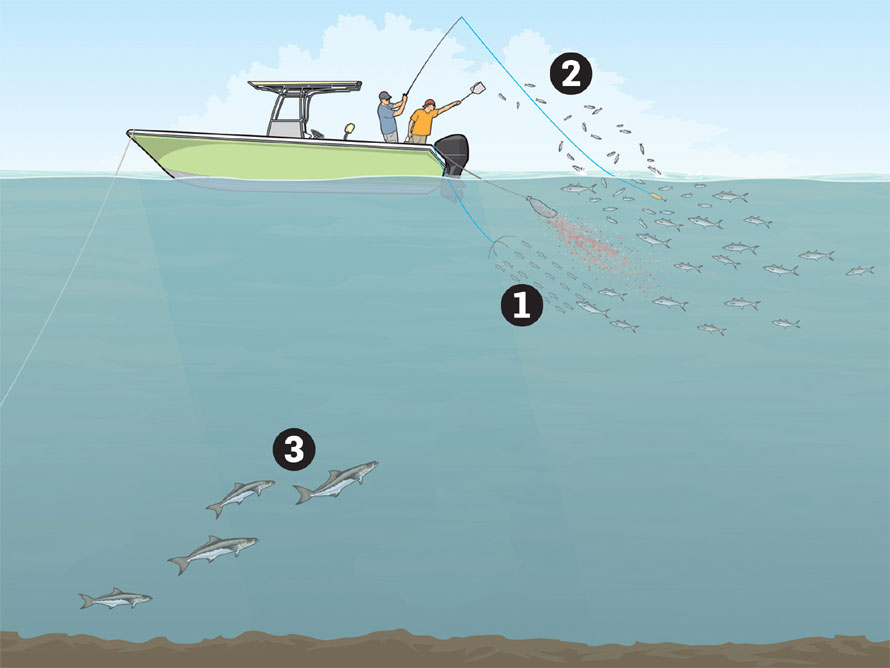Celebrating
|
Unorthodox Dredge Tactics
|
| Try These Proven Attractors Anywhere You Fish |
| by George Poveromo |
 |
| Dredges with Mylar baitfish silhouettes are easy to rig and drive fish crazy. We strive to create that perfect illusion, one which draws game fish into our bait spreads. Dredges have long been instrumental in offshore trolling, particularly for sailfish and white marlin. Generally trolled far back and deep while still remaining in view, these subsurface bait-school imitations appear to be fleeing predation. Add daisy chains or hookless teasers to kick up the surface, along with a spread of surface trolling baits staggered behind these dredges to appear as weak links isolated from their schools, and game fish will be hard-pressed not to at least venture in for a closer look. Some sport-fishing pros have figured out that dredges are also deadly in applications outside of trolling, and most of them remain tight-lipped as they reap impressive catches and tournament money because of these fish attractors. More on their non-trolling dredge secrets in a bit. Large tournament boats trolling for sailfish and white marlin have crews who fabricate fresh mullet-and-ballyhoo dredges, which is a time-consuming and laborious undertaking. By comparison, the advent of holographic fish-strip dredges has opened this style of fishing to nearly every angler on any size boat. For example, New Jersey’s Strike Point Tackle is a leading company in the holographic dredge business. Its dredge bars are available in stainless or titanium, collapsible or fixed, and in configurations of 12, 24 and 36 inches, complete with holographic strips ranging from 28 to 156 fish, which come in silver, blue or pink. It can fabricate any size rig with as many fish as an angler desires. As childish as these holographic fish may appear, they unveil lifelike baitball illusions as they swim, pulsate and flash. |
 |
| 1. Downwind: Assign someone to manage the kite and kite baits. They require frequent adjustments. 2. Upwind: Another crew member should man the upwind lines, the dredges and have a pitch bait ready. |
| When the Trolling Stops As noted, holographic fish dredges are not just for trolling. When fishing for South Florida sailfish, for instance, many anglers drift a full spread of live bait from kites and flat lines, and deploy at least one dredge either off the bow or amidships (based on drift). The dredge, generally a minimum of 100-plus fish, is weighted and positioned between 10 and 15 feet down; it undulates and flashes, and appears as a baitball holding tight to the vessel. Often, a second dredge is deployed, its depth staggered with the other. As the boat drifts and rocks, these holographic fish strips acquire a rhythm, moving in unison, reflecting light and attracting sailfish; as a sailfish nears the boat, it will likely eat a hooked bait or appear on the dredge where it can be pitch-baited. Should you have to chase a hooked sail, provided the boat is backing down on the fish, a close watch is kept on the now slow-trolled, bow-positioned dredge because another sail or two could easily rise to it. That same dredge/drifting tactic also pulls in blackfin tuna and kingfish. A little farther offshore, drifting a dredge while working over a school of dolphin will keep them around. It will also help to draw them to the boat when shutting down to chunk or live-bait a stretch of weeds or flying fish showers. |
 |
| Holographic Dredge Care Based on the size of the dredge, considerable time can be spent attaching the clips and holographic fish strips to the arms (bars). The good news: They don’t have to be disassembled for storage. Rich Adelman at Strike Point Tackle recommends clipping the ends of the dredge bar together by using the snaps that hold the strips and rolling the bar so the strips roll up around it. Then put the dredge in a ventilated bag and rinse with fresh water. That’s it. The dredge remains ready for quick deployment. As far as the strips crushing under any pressure, they’ll straighten out after a few minutes of trolling or drifting. On the Hook Another tight-lipped holographic dredge use: anchoring and chumming for Spanish and king mackerel. While on the hook as you thaw frozen chum off the transom and broadcast live pilchards to frenzied Spanish mackerel, try lowering a dredge several feet. Not unlike the live chum — most of which races back underneath the boat for security — the reflective fish strips help rally the Spanish mackerel to the boat and hold their interest. It undoubtedly enhances the potency of the frozen-and-live-chum combination. There's no telling what it may lure to the boat: cobia, jacks and even sailfish. The Night Shift Trolling dredges is commonly practiced in the mid-Atlantic and Northeast canyons. They can be productive additions when overnighting for tuna. Miami captain Bouncer Smith states it best: “When a boat is drifting at night for tuna and swords, lowering a dredge or two certainly isn’t a wasted effort,” he says. “Quite the contrary. Pelagics feed on assorted fish congregating under weed patches and floating debris. So, the more of an ecosystem and illusion of life created around the boat, the better the chances of attracting pelagics like tuna, swordfish, dolphin and marlin. Illuminated in the spread of underwater transom lights, along with the natural bait drawn to the lights, those dredges make set baits and chunking work to a captain’s advantage.” |
 |
| 1. Scent and Flash: Fish pick up the scent of the chum and are drawn to the dredge, which resembles a bait school under the chum bag. 2. Let it Rain: A steady dose of liveys tossed behind the boat gets any fish attracted by the frozen chum and the dredge in a feeding mode. 3. Get 'Em Up: Cobia, jacks, sailfish and even various bottom dwellers, like grouper and snapper, often come up to join the fray. Combining Chum and Dredges Using a dredge in combination with frozen and live-bait chum often produces amazing results. This clever strategy is particularly effective when fishing around structure from an anchored boat, which enables fish to detect and follow the chum line, be enticed by the dredge to get a closer look, and then be provoked to strike by a periodic shower of live baits tossed off the transom by a crew member. This technique works best for pelagics, but it often draws bottomfish as well. Inshore Duty Small holographic dredges bolster success when drifting for seatrout, weakfish, bluefish and striped bass in bays and sounds. Simply lower a dredge a few feet as the boat drifts over good bottom or through pockets of baitfish. Again, position the dredge deep enough so it completely unfurls to undulate, reflect light and rally fish. Small dredges work best here. I’ve tied off a small dredge with success while drifting deeper grass beds and channel edges in Biscayne Bay. Based on the drift (without influence from a trolling motor), experiment by paying out additional line. It’s a balancing act that requires just the right amount of weight or the lack thereof, to avoid disturbing the bottom. Wind actually helps, increasing drift speed. Once the dredge is set, cast well behind it and work the lure up to and beyond it to capitalize on any stalking fish. Hold Your Dredges Using a dredge in unorthodox fashion requires more concentration than when trolling it. It’s not only about being creative but also remembering the dredge is overboard. Remove dredges from the water before putting the boat in gear to chase a fish or make a move, or even before using the trolling motor to creep a couple hundred feet to the next grass bed. If you want to keep one out while chasing a fish, be aware of its position so it won’t foul on the hull or engines. Also, keep an eye on it; there’s always a good chance another game fish could appear behind it. |

